Word count: 4153. Estimated reading time: 20 minutes.
- Summary:
- The HLK-LD2412 human presence detection radar sensor is a small, low-cost device that can detect the presence of humans in a room. It uses radar technology to achieve this and has a range of up to 6 meters. The sensor can be configured to detect stationary or moving people, and it can also track multiple people in an X-Y space. However, its algorithms can either do stationary human detection well OR multiple human tracking well, but not both at the same time.
Tuesday 22 July 2025: 22:23.
- Summary:
- The HLK-LD2412 human presence detection radar sensor is a small, low-cost device that can detect the presence of humans in a room. It uses radar technology to achieve this and has a range of up to 6 meters. The sensor can be configured to detect stationary or moving people, and it can also track multiple people in an X-Y space. However, its algorithms can either do stationary human detection well OR multiple human tracking well, but not both at the same time.
Still, forwards we proceed as everything I get done now is one less thing to do later. And I have been getting in a lot of extra time with the kids by doing Irish tourist day trips – for the most arduous of our many recent day trips I made Clara and Henry climb to Coumshingaun Lough which is 2 km along the Earth’s surface, but also 250 metres upwards a steep, slippy incline. The weather involved periodic bursts of heavy rain and howling winds, so they weren’t entirely happy by the time they got to the top even with views like this:

Me, I was very glad to have finally crossed that one off my list. It was well worth the climb and suffering in my opinion, it is just stunning up there. We’ve done most things within an hour’s drive from home, but we have a long way to go on the list of things within ninety minutes drive. Ireland really is amazing for that type of tourism – it’s so much more authentic than what Amsterdam has become, where its centre has become more like a theme park pastiche of itself than what I remember of it from the 1990s. Thankfully, if you walk about 45 minutes away from the centre real genuine true Amsterdam is still there as I remember it – despite even out there having a lot of foreign tourists milling around. But, like with the many foreign tourists also climbing with us to Coumshingaun Lough, in the outskirts of Amsterdam the tourists add rather than subtract from the place as they do in the centre of Amsterdam. I haven’t been to London in well over a decade now, I expect it to also suffer from overtourism, but I’ll find out next week.
Last post in the series on my house build I said I have these three projects remaining awaiting testing and writeup here:
- Differential pressure sensor testing.
- Thermally broken kitchen extractor testing.
- Radar human presence sensor testing.
Today’s post will be mainly about human presence sensors. I have begun the other two – I have already accidentally melted a part of the test assembly for the thermally broken kitchen extractor, and I have soldered up the breadboards for the differential pressure sensor testing. But before I get onto human presence sensors, I mentioned last post that we ended up purchasing a Fiido D11 2025 edition for Megan’s commute bike, so let’s do that first.
Fiido D11 bike (2025 edition)
You may find reading my post on choosing an electric bike useful to read first, particularly at the end where I compare all the currently available foldable ‘lightweight’ electric bicycles currently available for under the €1,500 Cycle to Work scheme Revenue budget limit. The D11 2025 edition is available for under €1,000 inc VAT delivered. The 2025 edition only launched in July, and we were one of the first to get one in the world.
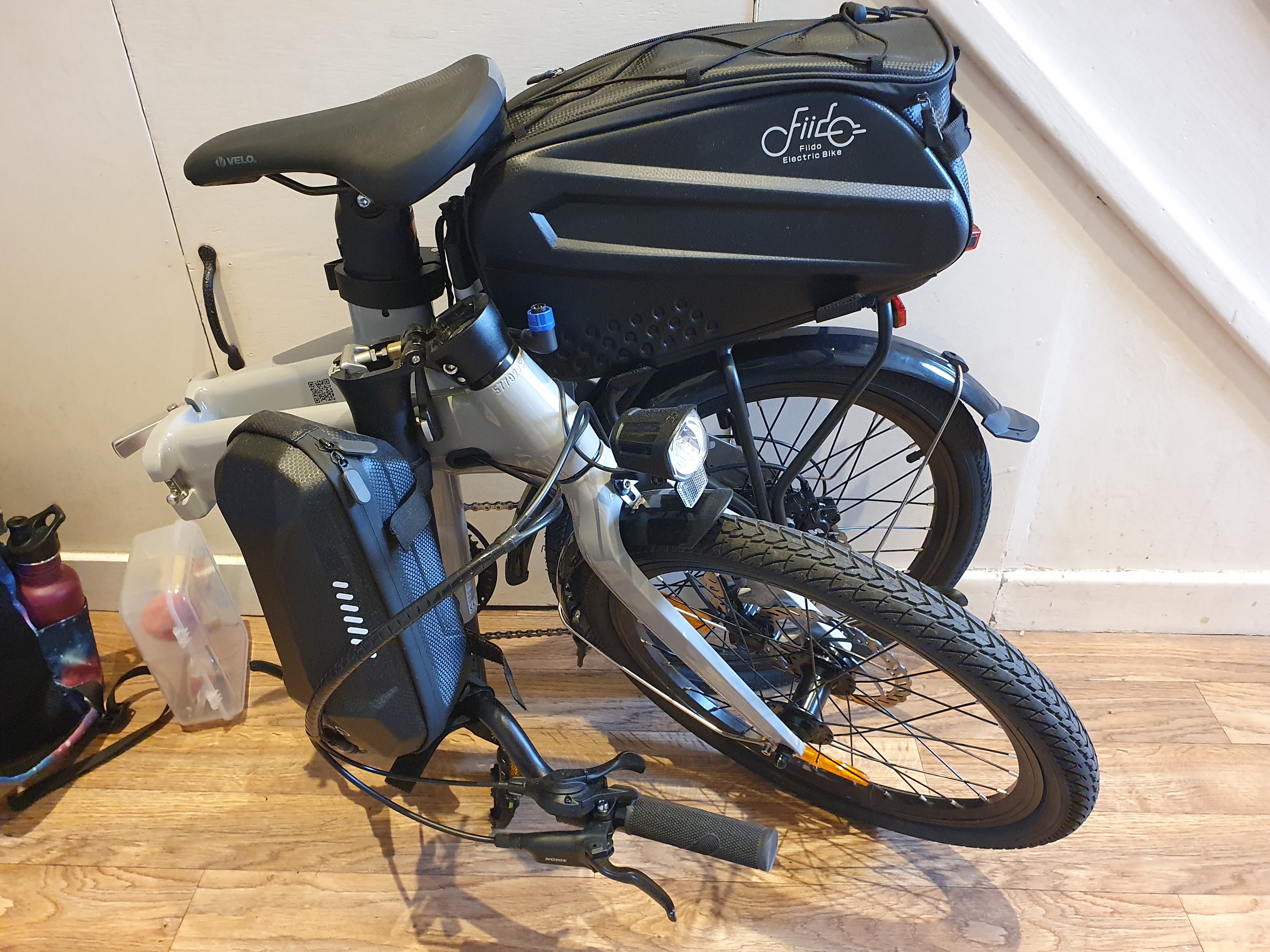
Megan's Fiido D11 commute bike folded up in the hallway
I wouldn’t call this bike light at around 23 kg. It’s heavy and awkward to lift even when folded. But it does fit into the boot of our cars, which is useful. Ride quality is unsurprisingly rough with the twenty inch diameter tyres. Handling is like all folding bikes – not great – but it is acceptable, and the folding locks are both tight and secure with no give nor rattle. The 36v based electric motor is just about powerful enough, and you will need to help it going up steep hills. Its pedal torque sensor is the same model as on my T2 Longtail, and therefore you get the same oscillating power delivery which is irritating.
Those are all the middling points. In terms of strong positives, the battery life is indeed more than plenty – Megan only charges it once per week and she’d do about 18 km per day. So it certainly can do 80 km on a single charge. The tail light on it being mounted high under the saddle works very well. The electric motor does genuinely make commuting far more pleasant, especially on the steep hill up to home on the way back.
The biggest negative is without doubt the brakes. They’re cheap and they don’t work well – the stopping distance is lousy. I wish they’d fit traditional rim V-shaped brakes at this price point, as they’re simply better than cheap hydraulic brakes. So long as you don’t go fast, the poor stopping distance is acceptable, but I think Fiido missed a trick here as a better bike was possible for even less cost and weight – just fit rim brakes.
I haven’t tried this bike with the EU speed limits removed, but to be honest the power system is sufficiently weak it wouldn’t get much above 25 kph anyway on the flat. Add any wind and you definitely won’t be getting above 25 kph without you helping it.
Megan is pleased with the bike, and I suppose so am I for the money. I would have preferred the ADO Air 20 Pro which costs €1,499 everywhere in Europe except Ireland, where it costs €1,799. I think the ADO would be the better folding bike albeit for 50% more cost than the Fiido.
I just wish Fiido had put better brakes on the D11. I’m not asking for the monster brakes that the T2 Longtail has, but something less shit than on the D11 would be a big gain.
Incidentally, the T2 Longtail has been busy taking my children places during the summer so far. Here it is resting after taking us to a playground 20 km away, and at the summit of Bweengduff mountain:
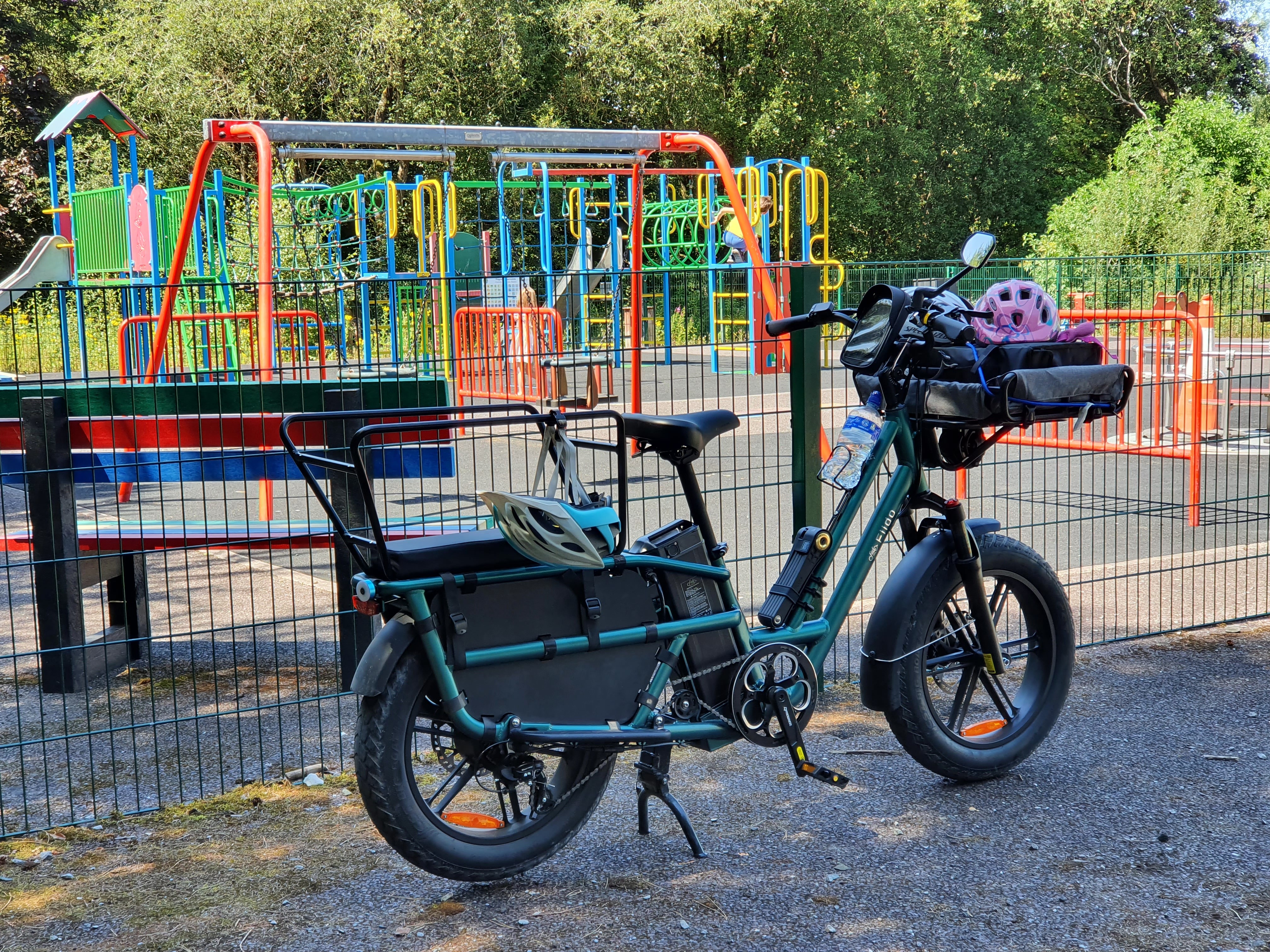
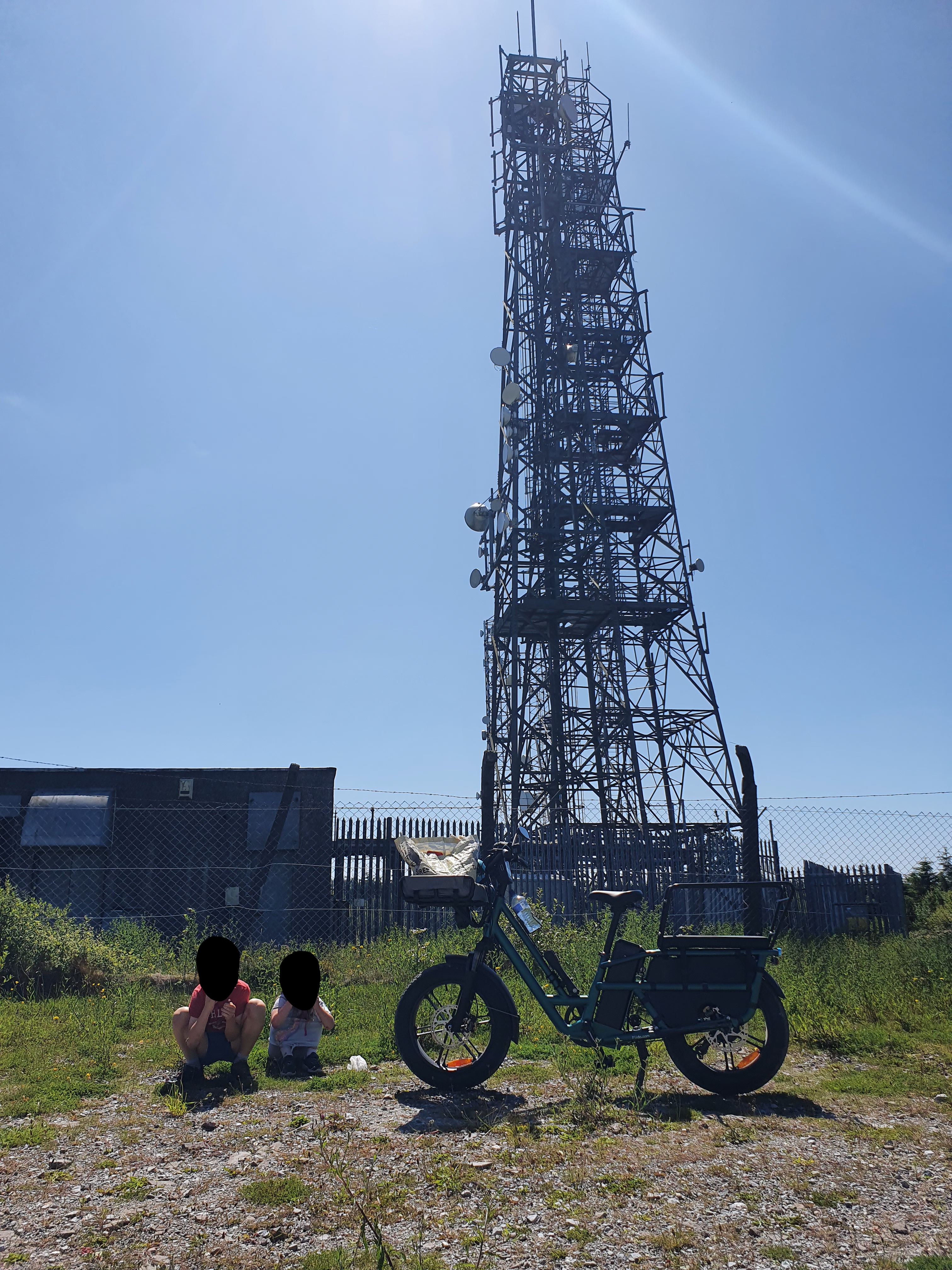
It was an especially hot day that day for Ireland at 28 C, so being able to tootle along at a nice refreshing clip was greatly appreciated by both myself and the kids at the time.
Getting to the top of Bweengduff mountain it gave out and refused to do further work due to overheating a short push of the bicycle from the summit. In fairness, it took us nearly to the top. It also very much took us down at speed on gravel, I was being extra careful due to the kids on the back, but boy that bike is a surprisingly excellent gravel bike. The brakes had to be on almost continuously to keep us under 50 kph, and they were so hot at the bottom of the mountain that they were clacking from metal expansion. What a bike! I’m looking forward to taking the kids to other places on it when we get back from London.
Human presence detection sensors
I’ve mentioned these on and off throughout the past four years on here, but I don’t think I’ve done a dedicated post before this. Human presence detection sensor modules suitable for operation by an ESP32 or Raspberry Pi come in many implementation techniques:
Passive infrared (like burglar alarm sensors or flood light sensors) e.g. HC-SR501.
- Characteristics: Range 7m when new (but shrinks with age); 120x120 degree field of view.
- Pros: a few euro of cost; works outdoors and in the rain; widest field of view; can disambiguate humans (or rather, warm moving things).
- Cons: needs a third of a watt power to work; they need movement over a fair distance to activate; they can’t sense distance; they tend to reliably fail after a few years.
Ultrasonic e.g. HC-SR04
- Characteristics: Range 2-3m; 30x4 degree field of view.
- Pros: sub euro cost; can measure distance very accurately; lowest power requirements of any solution (0.075 watts).
- Cons: extremely limited useful field of view; can’t disambiguate humans; long term reliability is also an issue with the cheaper Chinese modules; limited range, well under three metres.
Video with AI analysis e.g. Dahua IP cameras
- Characteristics: Range 100m; 120x90 degree field of view.
- Pros: very flexible, also lets human check visually; works outdoors and in the rain; wide field of view; can disambiguate humans.
- Cons: hundreds of euro of cost; distance accuracy is poor without a second camera; needs 15 watts of power (by far the most of out any option here).
Laser Time of Flight (ToF) e.g. VL53L8CX
- Characteristics: Range 4m (bright white objects, much less with dark objects); 60x60 degree field of view.
- Pros: can detect multiple objects within 64 zones and whether they are in motion or stationary; needs about a quarter watt of power.
- Cons: Cost about €15 inc VAT each (these are sub-euro models like the VL53L0X which do simple distance calculation and nothing else over a limited field of view); don’t work well with dark or non-reflective surfaces; can’t disambiguate humans; the sensor itself outputs histograms, and the analysis of those must be done in software by the microcontroller, which isn’t possible for an ESP32 unless it is fitted with extra RAM.
Radar e.g. HLK-LD2450
- Characteristics: Range 6m; 120x120 degree field of view.
- Pros: a few euro of cost; can detect distance of multiple objects and whether they are in motion or stationary; works outdoors; can disambiguate humans; has onboard DSP to do all the analysis so your ESP32 doesn’t have to.
- Cons: limited distance and speed resolution; some radar frequencies don’t work well in rain; needs about half a watt of power.
From four years ago onwards I tested options one to four – at the time, the radar based solutions were very new and not much good. I set up a passive infrared sensor in my living room, it worked for about three years with range reducing over time until the sensor died which is par for the course. The lack of resolution, and the constant need to have humans moving over its low resolution to keep the sensor on, ruled it out as a bedroom human presence sensor.
The ultrasonic sensor was cute and great for short range very tight field use cases. But I’d be thinking more ‘is the door open?’ type use cases, not ‘is a human present?’.
The video I’ve already done a post about, and it’s my preferred solution for outdoors and the public areas of indoors as it saves on lots of wiring, and I’d be recording most of those areas anyway. It isn’t viable within bedrooms for obvious reasons.
The laser based time of flight sensors were until now my best solution to this problem. I tested the VL53L0X ToF sensor which is a simple very cheap distance sensor, and it was great. Nearly as accurate as an ultrasonic sensor, similar range, can also work with non-hard non-perpendicular surfaces. But it really is mainly an alternative for an ultrasonic sensor.
I also tested the VL53L1 ToF sensor. The latest firmware can see bright white objects up to eight metres away – if not a bright white object, four metres is more likely. The results for this sensor were impressive, it could locate and track multiple objects with location, speed and direction. It did chew up a fair bit of a Raspberry Pi Zero’s CPU because the software analysis is all done on the CPU using raw data from the sensor. And the maths needed are non-trivial. But I came away surprised just how much information you can calculate from what is backscattered laser light if you can throw enough maths at the problem.
This brings us finally to the radar sensors. As mentioned earlier, I hadn’t investigated these until now as they were expensive, novel, and at the time not very good. But the technology has matured, and Hi-Link which is the principal Chinese vendor of cheap radar sensors has both driven down cost and greatly improved accuracy. I can, for above five euro, get a very good radar sensor now.
Radar human presence sensor categories
Radar sensors come in categories based on what radio frequency they use to implement the radar. There are the following radar implementations available as modules for integration into DIY projects currently on the market at the time of writing. I put in bold any showstopper type gotchas about each.
- 5.8 Ghz Hi-Link & Leap, 3-20 dBm power range
- Characteristics: Range 6m; 140x140 degree field of view; 150 mm max resolution.
- Pros: Part of ISM frequencies, so no licence required.
- Cons: Poor, but some, building penetration; collides with Wifi 5 Ghz 802.11p.
- 10 Ghz Hi-Link, 2 dBm power range
- Cons: Similar frequency to satellite TV; low range; requires licence to use.
- 24 Ghz Hi-Link & Leap, 6-20 dBm power range
- Characteristics: Range 9m; 120x120 degree field of view; 22 mm max resolution.
- Pros: Part of ISM frequencies, so no licence required; no building penetration.
- Cons: Absorbed by water and water vapour, which reduces range to a few kilometres at most
(but also makes this frequency range especially sensitive to bags of water
 ).
).
- 60 Ghz Hi-Link & MicRadar, 6-12 dBm power range
- Characteristics: Range 6m; 100x100 degree field of view; 10 mm max resolution.
- Pros: Part of ISM frequencies, so no licence required.
- Cons: Strongly attenuated by oxygen in the atmosphere which strongly reduces range to a few metres, which means it is generally always limited to within a room; collides with ‘WiGig’ 60 Ghz Wifi standard.
- 77-80 Ghz Hi-Link, 10-13 dBm power range
- Characteristics: Range 15m; 100x80 degree field of view; 8 mm max resolution.
- Pros: No building penetration; very versatile, can be used for everything from medical scanning to high bandwidth satellite uplinks.
- Cons: Lots of stuff uses this range due to its excellent properties; requires licence to use.
For human presence detection within a room, you generally don’t want to see into other rooms, plus 5 Ghz Wifi tramples all over the 5.8 Ghz radar option. The ~80 Ghz radar is amazing, but needs a licence for use. That realistically leaves the 24 Ghz and 60 Ghz radar options. Of those, the 24 Ghz radar is more interesting for human presence detection because big bags of water absorb most of 24 Ghz, so to the sensor humans stick out as big black shapes easy to disambiguate with a simple filter. As radar penetrates clothing, it can easily pick out micro movements like your heart beating in a way laser based solutions cannot. This makes 24 Ghz radar based solutions ideally placed to detect stationary but present humans e.g. if they are asleep in a bed.
24 Ghz Hi-Link radar sensor models
Hi-Link alone has dozens of radar sensor modules with use cases for everything between smart toilets to water tank gauges. I ran through the full list choosing only those likely to be useful for human presence detection within a typically sized bedroom, and eliminating old and legacy models. This list naturally fell out into three models, one per year. All can measure distance, all provide a serial UART interface which an ESP32 or indeed anything else can use, and I think all provide a Bluetooth interface (more on that shortly):
- LD2410b (released 2023)
- Cost: €1 inc VAT
- Transmit power: 13 dBm (79 mA module consumption)
- People count max: 1
- Position: no
- Range max: 6 m
- Resolutions: 0.2 m, 0.75 m
- Field of view: 120x120 degrees
- Needs 5v power supply
- LD2412S (just released in 2025)
- Cost: €3 inc VAT
- Transmit power: 13 dBm (90 mA module consumption)
- People count max: 1
- Position: no
- Range max: 9 m
- Resolutions: 0.2 m, 0.5 m, 0.75 m
- Field of view: 150x150 degrees
- Needs 3.3v or 5v power supply
- LD2450 (released 2024)
- Cost: €4 inc VAT
- Transmit power: 12 dBm (120 mA module consumption)
- People count max: 3
- Position: yes
- Range max: 6 m
- Resolutions: 0.75 m
- Field of view: 120x70 degrees
- Needs 5v power supply
The HLK-LD2412 human presence detection radar sensor
Of these, the LD2412 looked the most interesting for detecting if a human is in a bedroom, so I picked up three of them off Aliexpress for a tenner delivered:
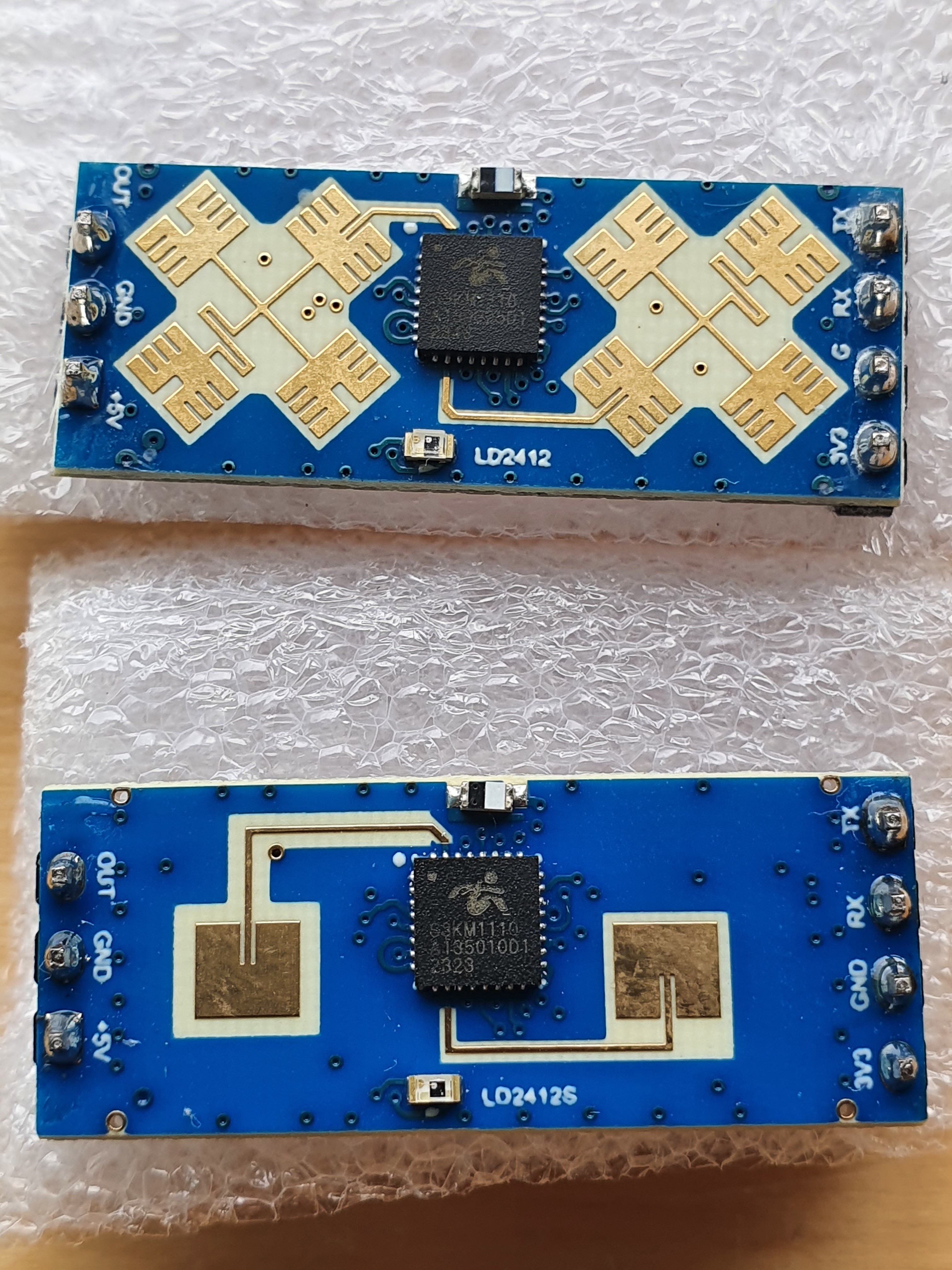
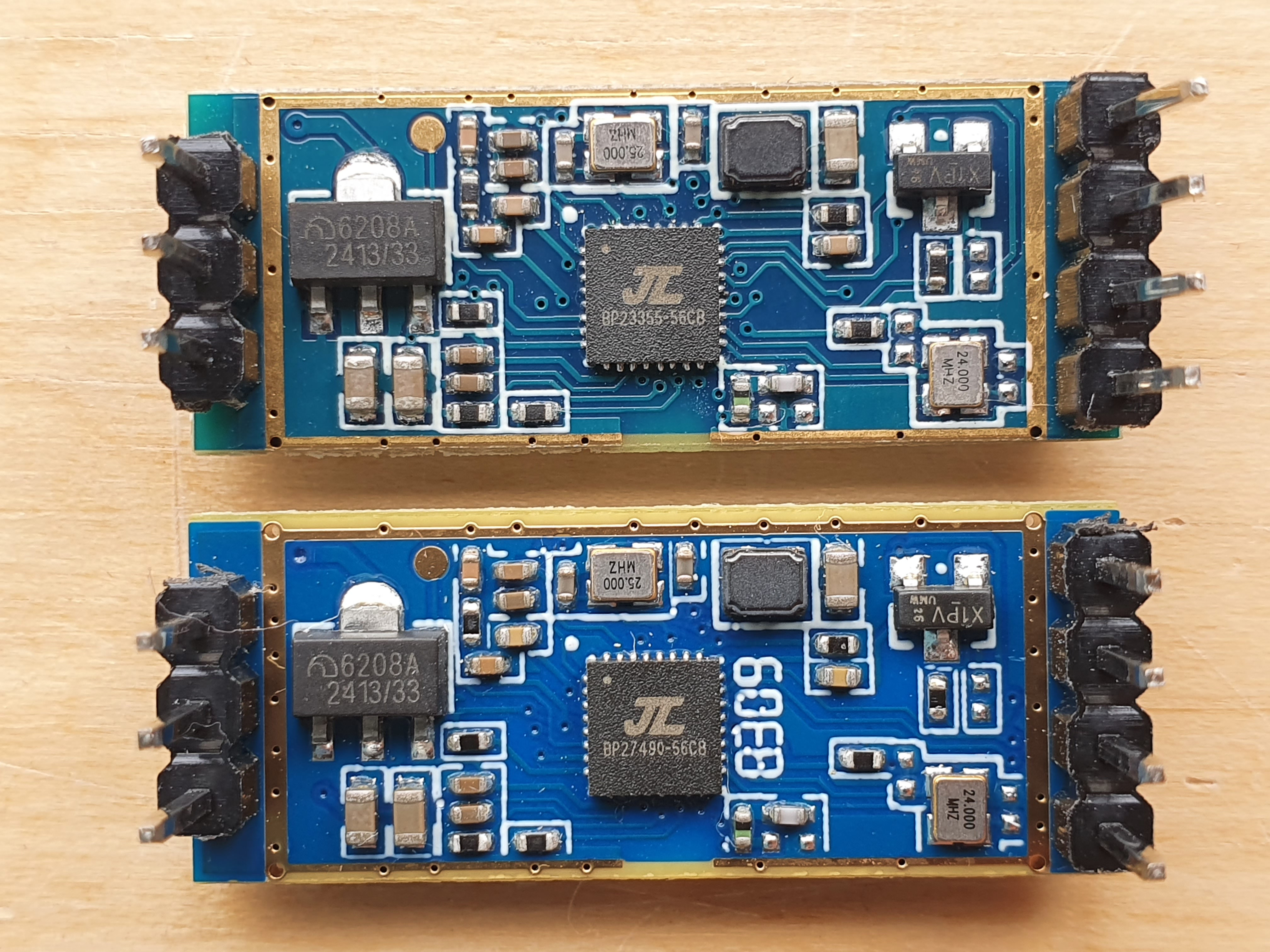
The top one is the LD2412 and the bottom the LD2412S – the latter is a v2 design according to the manufacturer, and the board layouts are indeed very similar. Something which Hi-Link has realised this year is that 5v powered boards are a pain, so they’ve added in the option of either or both 3.3v and 5v power options – onboard boost and buck converters will generate the missing voltage from the other as needed. This makes them far more convenient to integrate. They also dropped the default UART speed to 115200 which usually means you can skip bothering to wire in hardware flow control, another convenience. Finally, all three modules above have a Bluetooth transmitter thanks to their onboard DSP. It simply offers the serial communication over Bluetooth. And, to be clear, the Bluetooth aerial on these is lousy, plus there is zero security and nothing to prevent hijack, so I’d only use it as a temporary solution. But it certainly is very very convenient, and well done on Hi-Link for putting together such a DIY hobbyist friendly package for such a low cost (something which ST Microelectronics might want to think about for their ToF sensors).
So, does it work?
Testing the HLK-LD2412S human presence detection radar sensor using my laptop
As you saw, it correctly detects when a human is moving or stationary. It gives a fair approximation as to their distance given the 0.5 m resolution it is configured with – by measuring tape I’d say my legs were 2.55 m away from the sensor, and if you wait long enough it does seem to eventually realise this. If you move a little further away, it switches to 2.5 m, so I guess it might be a calibration thing. Also: this sensor is affected by bright light, and it was daylight outside and I hadn’t bothered to tell it to auto calibrate for light using its onboard light brightness sensor. In any case, the sensor definitely works as advertised.
You might notice mention of having set it to 0.5 m resolution, so I should explain that. The LD2412 has twelve ‘gates’. If you choose 0.75 m resolution, that is 9 m of range as 12 x 0.75 = 9; if 0.5 m resolution, that is 6 m of range; if 0.2 m resolution, that is 2.4 m of range. The 2.4 m range is just too short to reach my couch, it oscillates between seeing people stationary on the couch or not. It picks motion immediately even outside its maximum range, and of course it picks up stationary people within the 2.4 m range without issue. The 6 m range worked well for my 3 m wide room, as you saw in the video, but the granularity is coarse. Where things didn’t go well is the 9 m range, it really didn’t detect stationary people on the couch at all. My pet theory for this is that the wall behind the couch is reflecting radar back at the sensor, and if the sensor is trying to pick out humans up to six metres behind the wall, it gets overwhelmed. So the default setting of 0.75 m for this sensor would make it look useless in a 3 m room, which may explain some of the bad online reviews and commentary.
At the 6 metre range, I tried it with multiple people in the room – it reports the closest. I tried it from its side, and I think its 150 degree field of view is realistic. I tried to confuse it by being as still as possible by holding my breath, and I failed. It appears able to detect the micro movements of my heart no matter what I do. I am suitably impressed. If I leave the room, or go outside its range or its field of view, it realises within about one second, though its default setting is to wait for ten seconds before reporting absence. Consider me even more impressed – the signal processing mathematics to achieve this sort of accuracy and speed of reaction are non-trivial. All in a very easy to use package costing €3 inc VAT.
Why choose the LD2412 sensor when the LD2450 sensor looks better and for only one euro more? The LD2450 sensor which can detect and locate multiple people in an X-Y space would seem initially the better choice. However, online reports (and the manufacturer itself) say that stationary human detection greatly suffers as a result, with a reliable range of about two metres from the sensor. Basically the algorithms can either do stationary human detection well OR multiple human tracking well. If your use case is detecting how many people are in the room and where they are whilst moving, choose the LD2450. If you want to know if somebody is asleep in their bed, especially with a very wide field of view, choose the LD2412.
Which brings me to my final two things to mention about this sensor. The first is how to update its firmware – after all it runs its own DSP microcontroller on there, and they have greatly improved its firmware over time. So you really do want the latest firmware on there, and I can speak from testing experience on that. You update its firmware using Bluetooth from its mobile app. There are no alternatives. Its mobile app on Android seems incapable of actually updating the firmware as it always errors out, at least from the day I spent trying to make it work. Lots of others on the internet report the same. I was resigned to giving up, when it occurred to me that Apple Silicon Macbooks can now run iOS apps directly. So I gave it a go, and indeed the iOS app running on my Macbook worked seamlessly and updated the firmware without issue. In fact, that iOS app is what you’re seeing run in the video above, it was just easier for testing and videoing. So if you’re reading this trying to figure out how to update the firmware on these Hi-Link devices, now you know how: get an Apple Silicon device.
The second thing about this sensor is that individual gates can be configured for sensitivity if you wish. If you want to detect people at say 1.5 m and at 7.5 m only, and ignore all humans at all other distances from the sensor, that is very easy to configure. This means you can have a sensor detect if somebody is between the kitchen island and kitchen counter, and not trigger if they are anywhere else. This I think should be very useful indeed down the line. In short, I am won over by this type of sensor, from my testing I think it’s quite the game changer for what has been traditionally quite a tricky problem to solve well.
Finally, you can hide this sensor behind a few mm of ABS plastic without affecting it. This means bedroom human presence detection can be completely invisible. Nice!
What’s next?
I might get the thermally broken kitchen extractor testing done this coming weekend before we head off to London for the week. If not, then surely not long after our return.
Next comes the differential pressure sensor testing. That is surely doable in the three weeks of summer remaining before the WG14 standards meeting.
After I return from the WG14 standards meeting, the summer holidays for the kids will be over and I’ll be released from childcare. I guess it’ll be finally time to seriously start looking for work, though I may wait until the Monad cryptocurrency mainnet launches, as I did informally agree to remain available to them until then. Supposedly that will be some time in September, so only a few weeks more – and I surely could fill those weeks doing 3D services layout (and maybe a day out with the T2 Longtail on gravel tracks if the weather were nice one day).
| Go to previous entry | Go to next entry | Go back to the archive index | Go back to the latest entries |